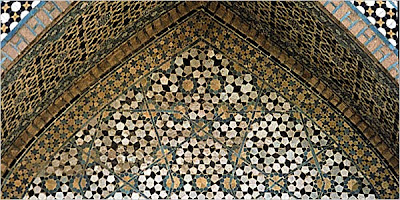
Some 500 years before the first quasicrystalline shapes were described by mathematician Roger Penrose, Islamic artists developed tiles that can be combined into the world's first man-made quasicrystals.
Penrose described the mathematical formulae for quasicrystals for the first time in 1974. Also called the "Penrose tiles", quasicrystals are geometrical patterns that have the wonderful property that if you extend them to infinity in any direction, they will never repeat themselves! Since this form of math was described, many quasicrystals where discovered in nature such as the arrangement of atoms and molecules in certain solids and liquids, that accounts for their unusual resistive and elastic properties.
Here is a typical example of a Penrose tiling pattern:

Today, quasicrystals are established math. The development of such math helped us better understand many natural phenomena, as well as develop better technology whether relating to materials, alloys, or electronics.
However, most people don't know that Islamic Art relied heavily on quasicrytalline shapes a long, long time before they were first formally described. The title image above is of a quasicrystalline Penrose pattern at the Darb il Imam shrine in Isfahan, Iran. Built in 1453!
It appears that architects of that era developed a set of carefully shaped tiles: a bow tie, pentagon, diamond, elongated hexagon, and large decagon. Arranging these tiles in different ways allows for wonderful patterns that, unlike any other tiling done before or after, never repeats its patterns! Consider the following pattern portrayed on a Turkish mosque, and its mathematical counterpart shown directly below it.


Such mastery of design suggests that the architects had knowledge of what would be described TODAY as advanced math. It also implies that medieval science of the East ought to be taken much more seriously than we presently think of it. Who knows what other scientific phenomena are described in there, waiting to be "discovered" by present day's mathematicians? If only one were to take pieces of history outside of history books, and put them to the test in today's world as plausible scientific players, who knows what would come out of it?
I leave you with one more example; An intricate strapwork pattern from an interior archway in the Sultan's Lodge in the Green Mosque in Bursa, Turkey, dating to the year 1424. Another ancient quasicrystal...

Comments
You know, sometimes things turn out to be wonderful after spending times not knowing they even exist. However, we should always look at things from the right point of view, taking all the aspects into consideration. :p (2007 Guess who)
I was sure this would be a nice way to make my first post!
Sincerely,
Robin Toby
if you're ever bored check out my site!
[url=http://www.partyopedia.com/articles/nascar-party-supplies.html]nascar Party Supplies[/url].